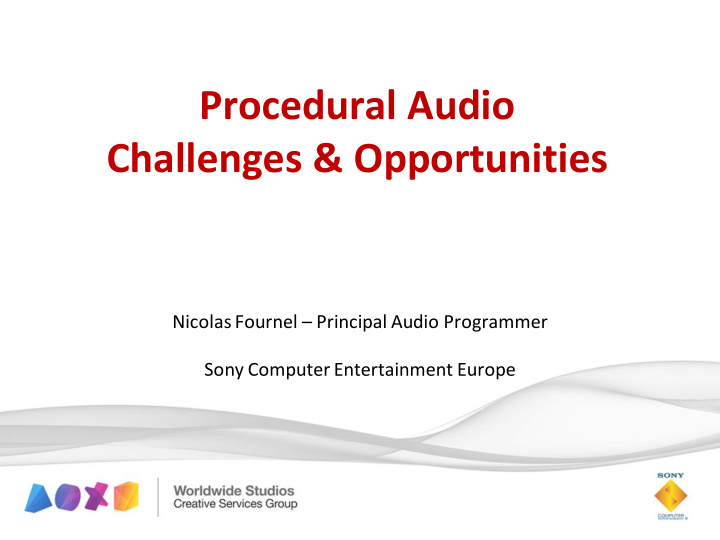



Procedural Audio Challenges & Opportunities Nicolas Fournel – Principal Audio Programmer Sony Computer Entertainment Europe
Overview • What is it ? • What are the opportunities ? • What are the challenges ? • How can we deal with them?
What is Procedural Audio ? Generation of audio assets at run-time with a model Using parameters coming from the game engine For the 3 main areas of game audio: • Sound effects: real-time sound synthesis (e.g. SoundSeed) • Dialogue: speech synthesis (e.g. Phonetic Arts) • Music: algorithmic composition
What is Procedural Audio ? It’s all about creating asset models rather than assets: • sfx synthesis model • voice model • composer / piece model In some regards, similar to 3D models in graphics
Opportunities • Fight repetition (e.g. footsteps, impacts) • Reduce memory footprint (e.g. wind, ocean waves) • Have more control: • evolving sounds (e.g. car engine, creature vocalizations) • better response to physics (e.g. rolling, sliding, scraping) • better response to motion controllers (e.g. whooshes)
Opportunities Procedural audio can also be used when: • It’s impossible to generate all the assets • vast universe • too many combinations • Requirements are only known at run time • sounds generation based on user-defined content
Challenges • It is harder to implement than sample playback • CPU cost higher and/or non linear • requires low level DSP programming • must interface more closely with other subsystems • It is harder to debug • more complex, more sources of bugs • harder to pinpoint what’s going wrong
Challenges • Pipelines are not ready. Mostly due to lack of: • trained sound designers / programmers / testers • adapted tools / run-time • ready-to-use models: • don’t know how to do it ! • results not “convincing” enough • not enough time to research the model • no collaboration within the industry
Lack of models : a vicious circle
Where can we get models ? Ready to use Procedural Audio models: • easy to use but… • limited to available models from the developer • limited to what parameters they allow • limited to the idea the creator of the model has of the sound Examples: • Staccato Systems already in 2000… • WWISE SoundSeed series • your audio programmer’s brain
Demo: Spark
Implementation with Patching • Tools such as Pure Data / MAX MSP / Reaktor • Sometimes hard to understand and inefficient due to the granularity of operators • Bottom -up approach • Requires knowledge in audio synthesis, mechanics, animal anatomy, physics etc…
Sound Design 101
A “simple” patch in Reaktor…
Another Approach ?
The top- down approach… • allows the sound designer to create a dynamic model from a static sound • without having an extensive knowledge of synthesis / sound production mechanisms • without having to rely on third party models • what makes it possible is…
Audio Analysis
Because we are using analysis… • We can use our own sounds as basis for a model • The modules can implement more complex behaviours • We can have a smaller number of modules (solves issues related to granularity)
Example: debris / impacts
1 - Distribution Model
2 - Impact Model
3 - Curve Model
Creature Vocalisations
Demo: Spark Tool
Conclusion: it’s all about the models We need better ways to create them: • from the designer’s sound (top - down approach) • using better tools (importance of audio features extraction) • while educating teams across disciplines To progress, we also need: • a game industry procedural audio working group • more collaboration with academia • to share models across the industry
Thank you! Any questions? Contact: nicolasfournel@yahoo.com nicolas_fournel@scee.net
Recommend
More recommend